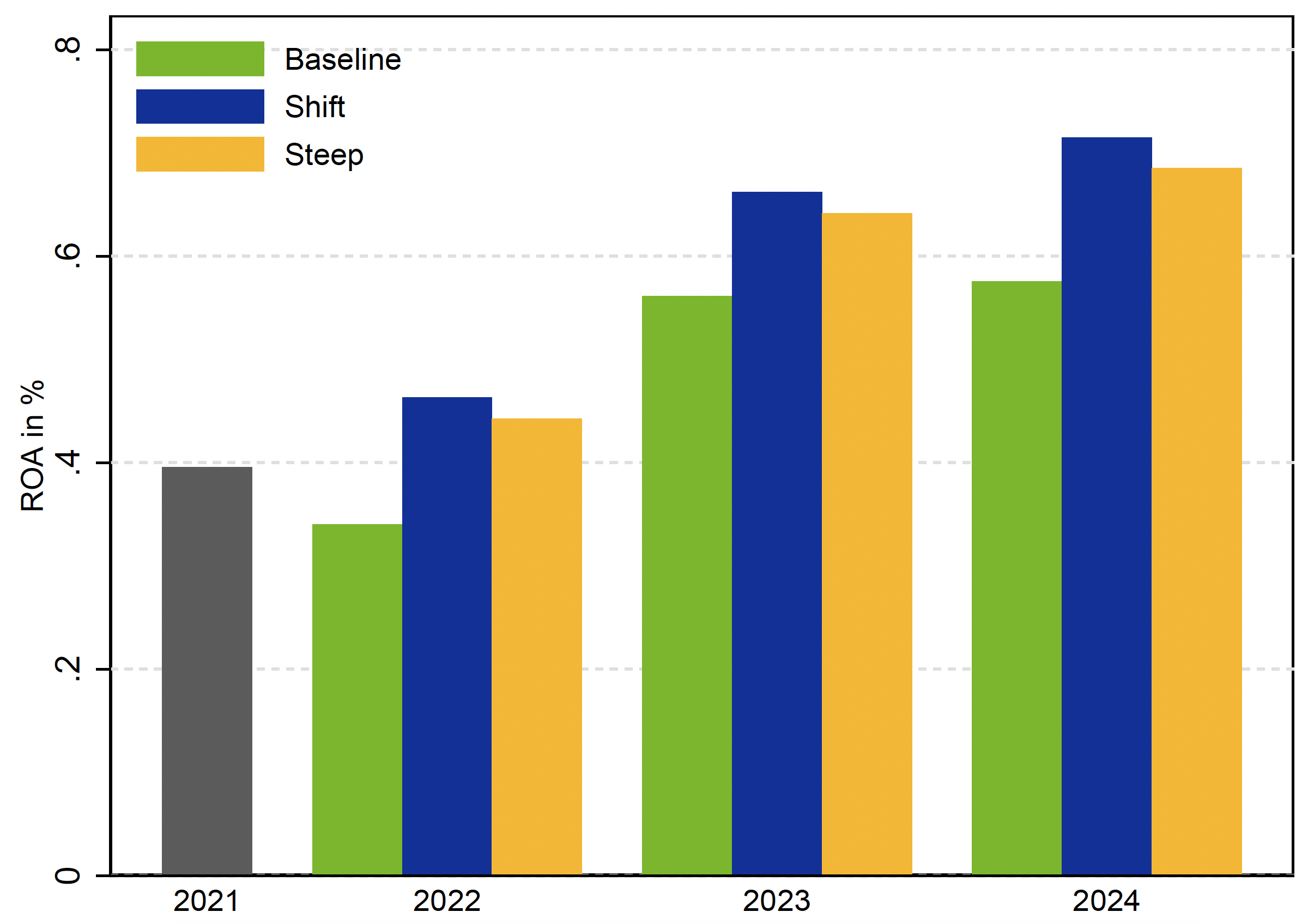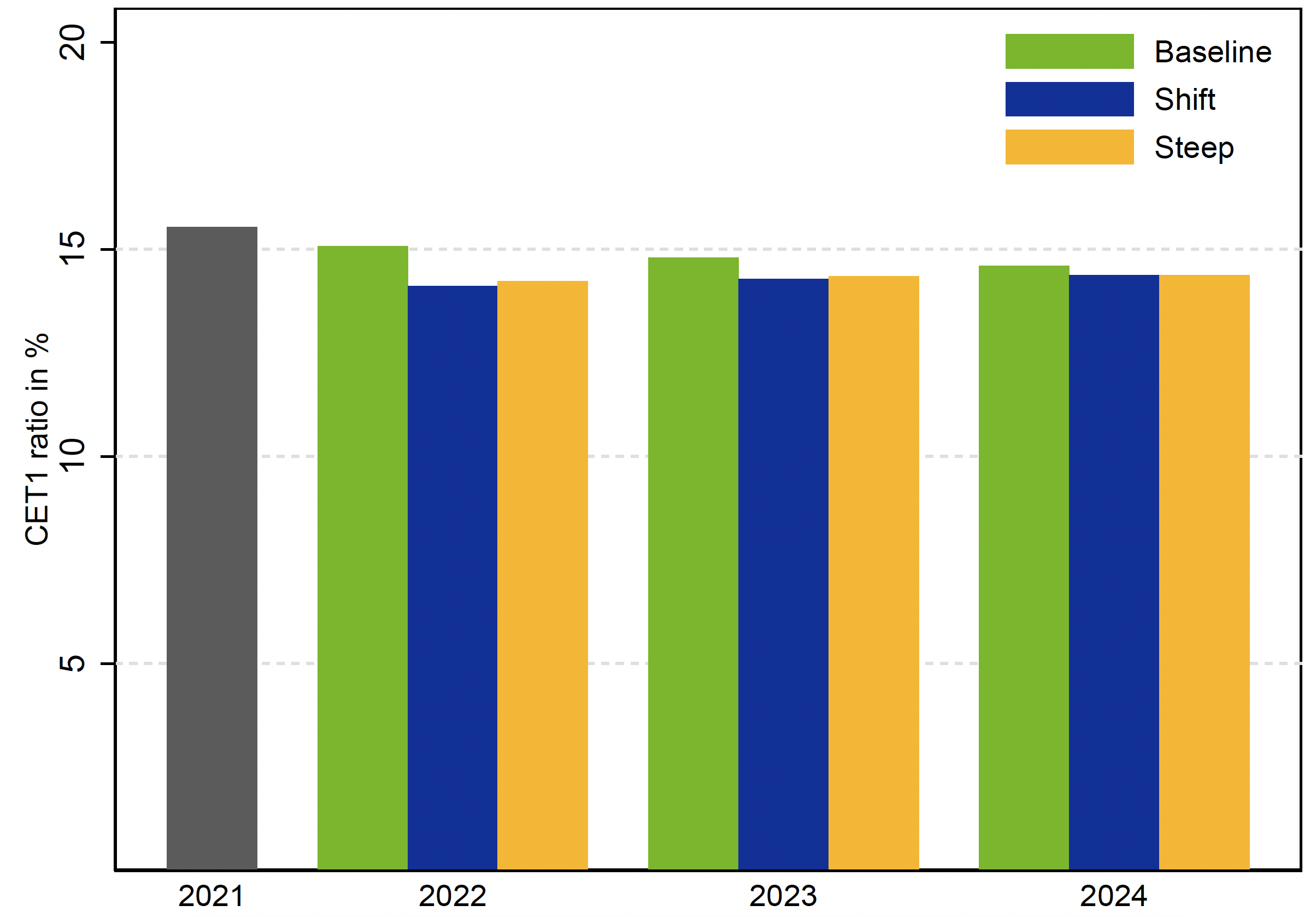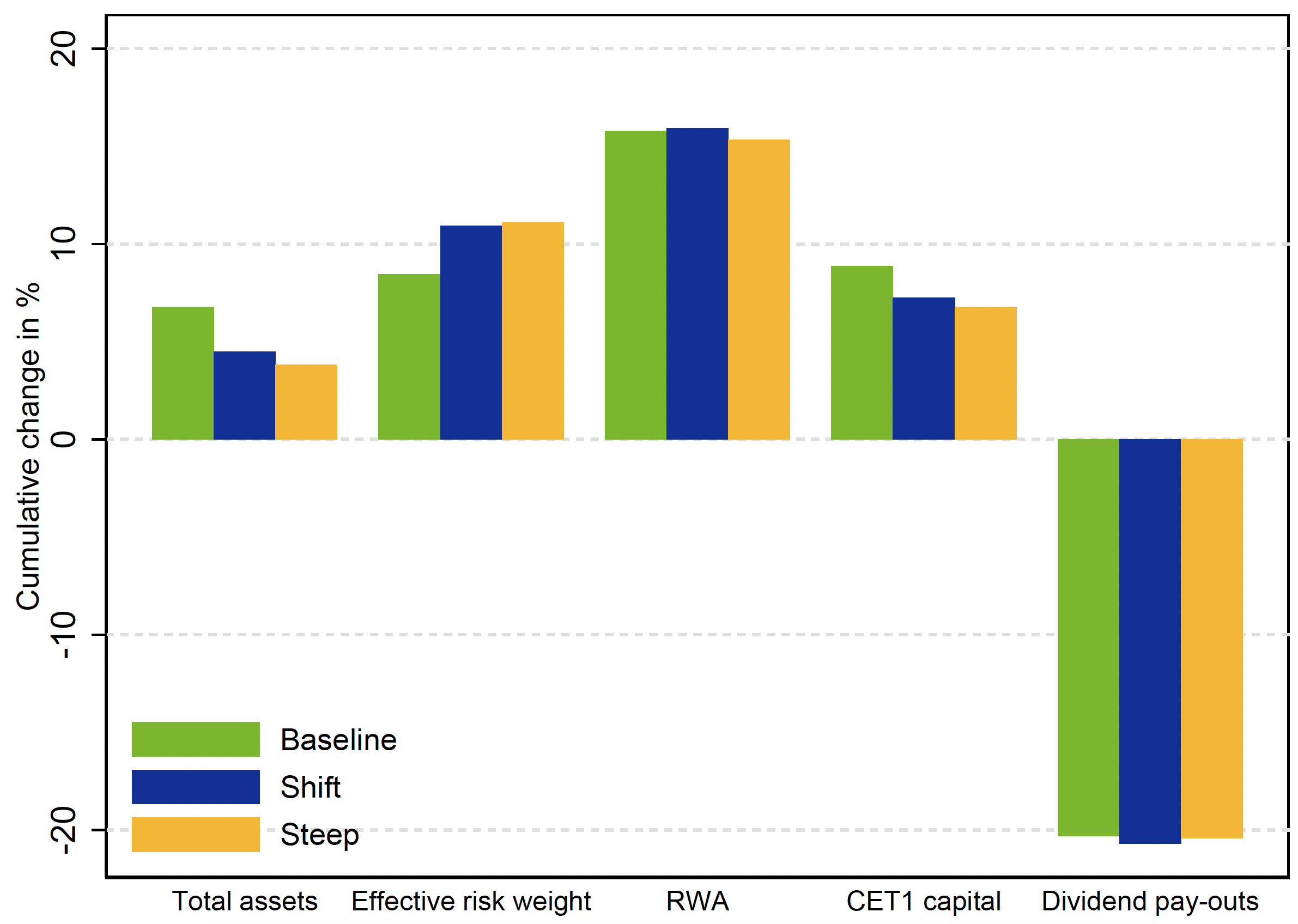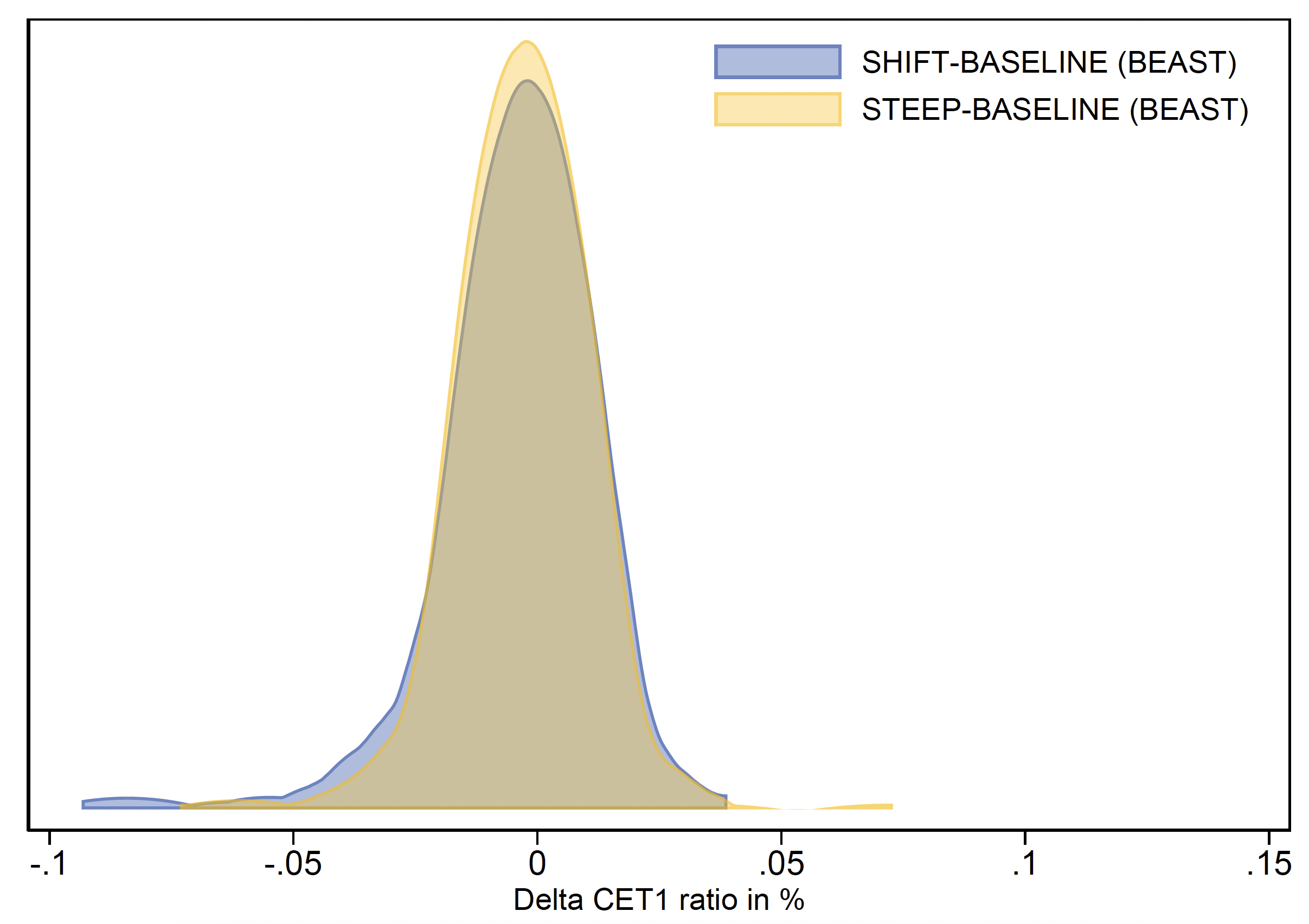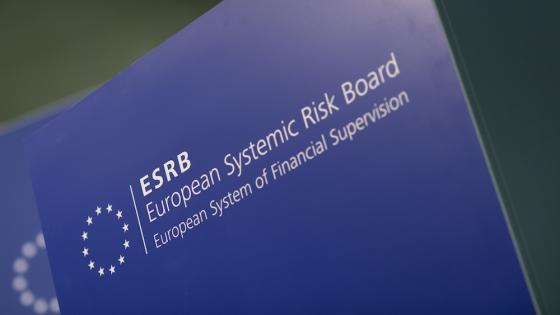Interest rates in the euro area have been low for almost a decade (Brei et al. 2020, Fell et al. 2021). However, following the increase in global inflation trends, central banks around the globe started tightening monetary policy in the first half of 2022. Despite the Russian invasion of Ukraine blurring the economic outlook in 2022 for the euro area, the expectations of a gradual normalisation of monetary policy started to drive market interest rates higher.
Sudden shifts in interest rates coupled with an inadequate management of interest rate risk can have unintended effects on financial stability. Banks perform maturity transformation and, thus, are directly exposed to interest rate risk which can affect their net worth (Dries et al. 2022) and profitability. This concern has grown over the past few years, as banks in the euro area lengthened loan maturities and increased the share of fixed rate (mortgage) loans.
A parallel shift and steepening of the yield curve
To assess the euro area banking sector vulnerability to interest rate changes at the beginning of 2022, we looked at the impact of two stylised interest rate scenarios. The macroeconomic forecast of the ECB from December 2021 set up the baseline, with robust economic growth despite remaining global supply constraints, growing stock markets, and a mild increase in short- and long-term interest rates with approximately stable spread. The two stylised scenarios built on this baseline but involved alternative evolution of interest rates and financial variables over the three-year horizon. The first assumed a yield curve shift of around 150-250 basis points across maturities compared to the levels at the end of 2021; the second, a steepening of the yield curve, with its 10Y end going up by 200 basis points, and its short end remaining firmly anchored at the starting point levels. The interest rate changes were coupled with the devaluation of equity and corporate bond prices, levelling up country-risk premia on government bonds especially in lower rating countries.
The two tiers of the analysis
We employed two ECB stress-testing frameworks, each making one tier in the two-tier analysis, and aiming to deliver robust results by mitigating model risks. The first framework assumes a constant balance sheet and relies on top-down models used in the context the EU-wide stress tests, coordinated since 2011 by the European Banking Authority, to quality assure bank projections (Mirza and Zochowski 2017). These are reduced-form regression models employing various estimation techniques and exploiting macroeconomic, sectoral, bank- or loan-level data to arrive at projections for credit, market risk parameters and net interest income components. The second tier offers a dynamic balance sheet perspective and relies on a workhorse macro-micro Banking Euro Area Sector Stress Test (BEAST) model (Budnik et al. 2020). This semi-structural model includes the representation of euro area economies and around 90 individual banks. The model is regularly used for both policy assessment (e.g. Budnik et al. 2021a) and macroprudential stress test (e.g. Budnik et al. 2021b). Favourably for our attempt to diversify model risk, the BEAST often employs different datasets or empirical approaches than the top-down models.
The constant balance sheet approach focuses on the impact of interest rates on loan-loss provisioning, asset valuation in banks’ trading books, and net interest income. Bank assets and liabilities that mature or amortise within the three-year horizon are replaced with similar financial instruments in terms of type, currency, geography, credit quality at date of maturity, and original maturity. Banks’ balance sheet consists of loans to different economic sectors, equity exposures, and securities on the asset side, and wholesale and retail funding on the liability side.
The dynamic balance sheet approach considers a broader number of channels, therein changes in risk weights, other than net interest income components of bank profitability, and endogenous banks’ reactions. Bank balance sheets are represented with a similar level of granularity as in top-down models. A share of model equations maps macro-financial conditions into bank-level loan-loss provisioning parameters, risk weights or funding costs, and other capture banks’ behavioural reactions such as adjustments in lending volumes, interest rates, liability structure, and profit distributions.
Positive profitability outlook…
It turns out that a sharp increase in interest rates, reflected in a parallel shift or steepening of the yield curve, could benefit banking sector profitability at the onset of 2022 (see Figure 1). The system-level return on assets (ROA) in the dynamic balance sheet approach increases mostly due to the positive impact of interest rate changes on net interest income (NII), and to a lesser degree on client revenues benefiting from higher interest rate volatility. These more than compensate for the negative impact from the revaluation of fixed income securities and equities. Last in order of materiality is credit risk and the negative impact of interest rates on some borrowers’ ability to honour their obligations.
Figure 1 System-wide return on assets (ROA), 2021-2024
Notes: The presented results are based on the dynamic balance sheet approach.
Sources: ECB.
… and hardly affected system-wide solvency forecast
The solvency impact of the two stylised scenarios is negative but very contained. The CET1 ratio decreases from 15.5% in 2021 to 14.5% in 2024 in the shift and steepening scenarios compared to 14.7% in the baseline. The right-hand side panel of Figure 2 breaks down the cumulative change in the CET1 ratio into CET1 capital losses which arise due to revaluation losses entering the capital calculation directly and not via profit and loss, a mild increase in the effective risk weight, and the mitigating impact of deleveraging. In the constant balance sheet approach and absence of the two latter adjustments, the difference between CET1 ratio in the shift interest rate scenario and the baseline goes up to 1.4 percentage points, and to 0.5 percentage points for the steepening scenario. Nonetheless, there is a strong (81%) correlation of bank-level solvency results between the dynamic and constant balance sheet approach. The two approaches also deliver similar correlation of bank-level results for NII (85% correlation coefficient) devaluation losses (52%), and loan-loss provisioning (36%).
Figure 2 System-wide CET1 ratio, 2021-2024 (left); Cumulative change in components of CET1 ratio (right)
Notes: The presented results are based on the dynamic balance sheet approach.
Sources: ECB.
Winners and losers
Though the average effect on the system solvency is slightly negative, there will be losers and winners among the institutions. Around half of banks experiences losses and the other half benefit from a sharp increase in interest rates in the dynamic and constant balance sheet approaches alike (see Figure 3). Among banks with relatively strongest negative impact of higher interest rates are development and promotional lenders, universal banks, and diversified lenders.
Figure 3 End of the horizon (2024) CET1 ratio differences between alternative scenarios and baseline for constant balance sheet (left) and dynamic balance sheet (right) approaches
Notes: TD – top-down ECB models and constant balance sheet approach; BEAST – dynamic balance sheet approach.
Sources: ECB.
What do we learn?
Overall, the euro area banking system in early 2022 has been well equipped to face an increase in interest rates, closing a decade of historically low interest rates. However, some banks appear vulnerable to some degree to a sharp revision of interest rates and at risk of experiencing substantial capital losses, and it remains essential to make sure that these are closely supervised and prepared to cope with sharp interest rate changes. The last months have started to test the robustness of this conclusion, with a gradual increase in market interest rates, especially in the long end of the yield curve. The euro area banking sector has so far weathered these increases against a much gloomier economic outlook than in our baseline, stained with the Russian invasion on Ukraine. All in all, while there are limits to how our stylised analysis can help the current monetary policy discussion, it is reassuring that banking system resilience does not appear to be at risk from monetary policy normalisation.
References
Brei, M, C Borio and L Gambacorta (2020), “Bank intermediation when interest rates are very low for long”, VoxEU.org, 7 February.
Dries, J, B Klaus, F Lenoci, and C Pancaro (2022), “Interest rate risk exposures and hedging of euro area banks’ banking books”, Box 5, ECB Financial Stability Review, May.
Fell, J, T Peltonen and R Portes (2021), “Lower for longer – macroprudential policy issues arising from the low interest rate environment”, VoxEU.org, 2 June.
Budnik, K, M Balatti, I Dimitrov, J Groß, M Kleemann, T Reichenbachas, F Sanna, A Sarychev, N Siņenko and M Volk (2020), “Banking Euro Area Stress Test model (BEAST)”, ECB Working Paper No. 2469.
Budnik, K, I Dimitrov, C Giglio, J Gross, M Lampe, A Sarychev, M Tarbe, G Vagliano and M Volk (2021a), “The growth-at-risk perspective on the system-wide impact of Basel III finalisation in the euro area”, ECB Occasional Paper Series, No 258.
Budnik, K, L Boucherie, M Jancokova, M Borsuk, J Karmelavicious, I Dimitrov, M Lampe, G Giraldo, G Vagliano, J Groß and M Volk (2021b), "Macroprudential stress test of the euro area banking system amid the coronavirus (COVID-19) pandemic", ECB.
Mirza, H and D Zochowski (2017), “Stress test quality assurance from a top-down perspective”, ECB Macroprudential Bulletin, Vol. 3.





